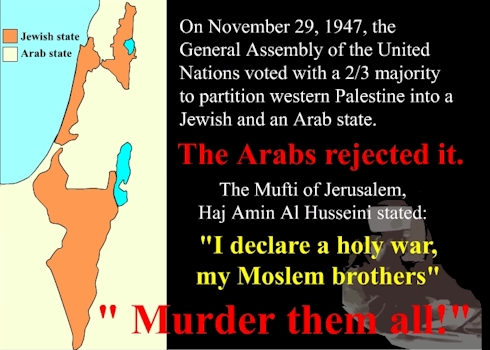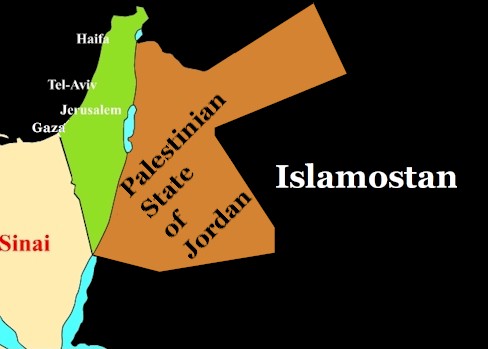HISTORY, NOT MUSLIM/LIBERAL PROPAGANDA
Under the terms of the Balfour Declaration in 1917, the whole world pledged “the establishment of a national home for the Jewish people” consisting of the territory as shown on this map, and mandated the British government to implement this directive. (Confirmed by the 1919 Faisal Weizmann Agreement).

In 1922, only five years after the Jews had been promised their own homeland, England revoked that promise, dividing “Palestine” into two administrative districts, and allowed the Jews only in the western portion.
In 1946 the British partitioned “Palestine,” stole about 70% of the “Jewish homeland,” and gave it to the Palestinian Arabs for the establishment of an independent Palestinian Arab state called Jordan.

On November 29, 1947, the United Nations attempted to take approximately half of the remaining 30% of the “Jewish homeland” away from the Jewish people and give that to the Arabs also. That would have left Israel with only approximately 15% of the area that was originally set aside for their national homeland.
Fortunately for tiny Israel, the Arabs rejected the offer, because for the Arab world the only acceptable solution to the “Jewish problem” is the complete extermination of all Jews.

Make no mistake about it. Israel is morally and legally entitled by International Law to occupy the entire territory of the original Balfour Declaration, including all of what is now the country of Jordan.
.
Let us have no more stupid talk about the creation of a Two-State solution. The “Two-State Solution” currently exists; there are two sovereign nations now occupying “the national home for the Jewish people”—Israel and Jordan. And let us have no more stupid talk about “the West Bank” or “the occupied territories.” Those geographical areas are Israel, period!
.
Those areas are no more “occupied territories” than is the Commonwealth of Massachusetts or the State of Texas. If there is an “Occupied Territory” in the Middle East, it is Jordan who is unlawfully occupying 70% of Israel’s homeland and the self-proclaimed “Palestinians” who are unlawfully occupying an additional 10-15% of Israel’s homeland. LINK

And here’s something modern history has conveniently forgotten: “Arabs welcome Jews home”
The Emir Hussein of the Hejaz replied “with an expression of goodwill towards a kindred Semitic race”, when the Balfour Declaration was communicated to him in 1918, and his son Feisal, acting officially for the Arab movement, wrote on March 3, 1919:Throughout Arabia, the chiefs were for the most part, distinctly pro-Zionist, as were the Palestinian peasantry, who were delighted at the benefits that Jewish immigration was bringing them. The Muslim religious leader, the Mufti, was openly friendly, even taking a prominent part in the ceremony of laying the foundation stone of the Hebrew University in Jerusalem.And what of “Arab nationalism”? At that time, no one had heard of a “Palestine Arab people”; the term was not invented until after 1964, entirely for political reasons. The British Peace Handbook No. 60, published in 1918, declared that “the people west of the Jordan are not Arabs, but only Arab speaking… In the Gaza district they are mostly of Egyptian origin; elsewhere they are of the most mixed race…they (the Arabs of Palestine) have little if any national sentiment…they hide their weapons at the call of patriotism.”The idea that Palestine should be Arab was never even contemplated. On the contrary, the attitude of the Arabs to the Jewish National Movement was one of almost unanimous approval. In 1906, Farid Kassab, a famous Syrian author, expressed the view uniformly held by the Arabs: “The Jews of the Orient are at home. This land is their only fatherland. They don’t know any other.” A year later, Dr. Moses Gaster reported that he had “held conversations with some of the leading sheiks, and they all expressed pleasure at the advent of the Jews, for they considered that with them had come ‘barakat’ – blessing, since the rain came in due season.”The Emir Hussein of the Hejaz replied “with an expression of goodwill towards a kindred Semitic race”, when the Balfour Declaration was communicated to him in 1918, and his son Feisal, acting officially for the Arab movement, wrote on March 3, 1919:XX“We Arabs look with the deepest sympathy on the Zionist movement. Our deputation in Paris is fully acquainted with the proposals submitted yesterday by the Zionist Organization to the Peace Conference and we regard them as moderate and proper. We will do our best, insofar as we are concerned, to help them through. We will wish the Jews a most hearty welcome home.” LINK H/T Art
In fact, there is a list of over 50 eminent people from more than 20 countries who appear in the gallery of non-Jewish Zionists. Representing the political, intellectual elite of many nations, many of them had traveled widely throughout the Land; but all – even those who had not – could hardly have been unaware of the written evidence – report after report – of travelers who testified as to the barren and desolate state of Palestine. The most famous was Mark Twain, who recorded after his visit in 1867: “Stirring scenes occur in the valley (Jezreel) no more. There is not a solitary village throughout its whole extent – not for thirty miles in either direction. ...One may ride ten miles hereabouts and not see ten human beings.” Of the Galilee, he wrote of “...these unpeopled deserts, these rusty mounds of barrenness...” Nazareth he described as “forlorn”, Jericho as “a moldering ruin”.
ReplyDeleteThirty years later, in 1898, German Kaiser Wilhelm II also visited Palestine. He was appalled at the condition of the country. The Ottomans had stripped the forests for lumber and firewood. The Palestinian Arabs had let an old Roman aqueduct fall into ruin. The ultimate ecological curse was the ubiquitous herds of black goats. For nearly 2,000 years after the dispersion of the Jews, Arabs had allowed their goats to graze unfenced across Palestine. They had eaten the grass down to its roots, and the topsoil had eroded and blown away. The biblical land of milk and honey had become a dust bowl.
In 1891, Dr. W.E. Blackstone, quoting the foremost authorities on international law, pointed out that since the Jews never gave up their title to Palestine, the general “law of dereliction” did not apply in their case; “for they never abandoned the land. They made no treaty; they did not even surrender. They simply succumbed, after the most desperate conflict, to the overwhelming power of the Romans...” Blackstone quoted the leading legal authorities of his day, who agreed that the Jewish claim is legally sound – and this remains so to this day.
Arabs Welcome Jews Home
And what of “Arab nationalism”? At that time, no one had heard of a “Palestine Arab people”; the term was not invented until after 1964, entirely for political reasons. The British Peace Handbook No. 60, published in 1918, declared that “the people west of the Jordan are not Arabs, but only Arab speaking... In the Gaza district they are mostly of Egyptian origin; elsewhere they are of the most mixed race...they (the Arabs of Palestine) have little if any national sentiment...they hide their weapons at the call of patriotism.” The idea that Palestine should be Arab was never even contemplated. On the contrary, the attitude of the Arabs to the Jewish National Movement was one of almost unanimous approval. In 1906, Farid Kassab, a famous Syrian author, expressed the view uniformly held by the Arabs: “The Jews of the Orient are at home. This land is their only fatherland. They don’t know any other.” A year later, Dr. Moses Gaster reported that he had “held conversations with some of the leading sheiks, and they all expressed pleasure at the advent of the Jews, for they considered that with them had come ‘barakat’ – blessing, since the rain came in due season.”
ReplyDeleteThroughout Arabia, the chiefs were for the most part, distinctly pro-Zionist, as were the Palestinian peasantry, who were delighted at the benefits that Jewish immigration was bringing them. The Muslim religious leader, the Mufti, was openly friendly, even taking a prominent part in the ceremony of laying the foundation stone of the Hebrew University in Jerusalem. The Emir Hussein of the Hejaz replied “with an expression of goodwill towards a kindred Semitic race”, when the Balfour Declaration was communicated to him in 1918, and his son Feisal, acting officially for the Arab movement, wrote on March 3, 1919:
We Arabs look with the deepest sympathy on the Zionist movement. Our deputation in Paris is fully acquainted with the proposals submitted yesterday by the Zionist Organization to the Peace Conference and we regard them as moderate and proper. We will do our best, insofar as we are concerned, to help them through. We will wish the Jews a most hearty welcome home.
Presidents Harding (signed a resolution past by Congress and the Senate in 1922 recognizing The Palestine Mandate as the reconstituted Jewish National Home) and Coolidge confirmed and approved the Mandate for Palestine, a trust agreement carried out by The British as trustee for the Jewish people, recognizing the Jewish People’s immediate right to close settlement on their historical land and a future right to rule when their population achieves a majority, as a sovereign Nation when that became practical. The recognition of a state may be express or tacit. The latter results, from any act, which implies the intention of recognizing the new sovereign state.
ReplyDeleteOn January 3, 1919 the Faisal Weizmann Agreement was executed, which recognized Palestine as The Jewish National Homeland. In a report delivered on January 21, 1919, the tentative proposal of the US for settlement of WWI at the Paris Peace Talks incorporated The 1917 Balfour Declaration and provided for the automatic acknowledgement of Jewish sovereign statehood when it met conditions that made it practical for the Jews to exercise sovereignty. The vesting of the legal domain of political self-determination would be self-executing. The Jewish People’s collective right to political self-determination would vest when that occurred. It is understood that any agreement and terms survive in perpetuity.
"We have flown the air like birds and swum the sea like fishes, but have yet to learn the simple act of walking the earth like brothers"
If you read the 1917 Balfour Declaration (Which emulated Napoleons 1799 letter to the Jewish community in Palestine promising that The National Home for The Jewish people will be reestablished in Palestine, as the Jews are the rightful owners). Nowhere does it state an Arab entity west of The Jordan Rive. The San Remo Conference of 1920 does not state an Arab entity west of The Jordan River. The Mandate for Palestine terms does not state an Arab entity west of the Jordan River. It specifically states a Jewish National Home in Palestine without limiting the Jewish territory in Palestine. It also states that the British should work with the Jewish Agency as the official representative of the Jews in Palestine to implement the National Home of the Jewish people in Palestine. I stress again; nowhere does it state that an Arab entity should be implemented west of the Jordan River.
ReplyDeleteAs a matter of historical record, The British reallocated over 77% of Jewish Palestine to the Arab-Palestinians in 1922 with specific borders and Jordan took over additional territory like the Gulf of Aqaba which was not part of the allocation to Jordan.